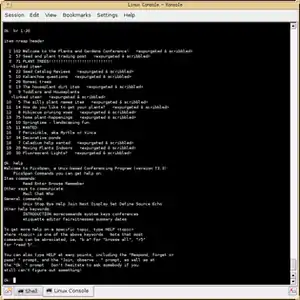PicoSpan
Picospan was a popular computer conferencing tool written by Marcus D. Watts for the Altos 68000. It was written in 1983, for the most famous and popular computer conferencing system at that time, called M-Net, which was owned and operated by Mike Myers. Sometime in 1984, Marcus's employer, an Ann Arbor company called Network Technologies International (NETI) purchased the rights for PicoSpan planning to develop it into a commercial product called E-Forum.
 | |
| Developer(s) | Marcus D. Watts |
|---|---|
| Initial release | 1982 |
| Written in | C |
| Operating system | Unix |
| Available in | English |
| Type | BBS |
| License | Commercial Proprietary software |
History
Computer conferencing was first pioneered in Michigan on CONFER, PicoSpan, E-Forum, Caucus and Participate.[1]
Functionality and Impact
PicoSpan tried to provide CONFER's functionality while using the least amount of resources, though many users found it hard to use. It formed the basis for many conferencing systems run by hobbyists.[2][3][4]
Picospan came with a toolbox of software customization utilities that could be used to make changes at the system and user level. It was tightly integrated with Unix and could provide transparent access to many external programs that formed a part of the Unix environment.[5] Typing "unix" at the Pico prompt put the user in a shell and users could rapidly switch back and forth and move text from one to the other.[6]
Marcus had a direct effect on The WELL's culture: PicoSpan prevented censorship by preventing conference hosts (who are empowered to hide or delete any response posted in their forum) from influencing a discussion, by labeling such posts as being "<censored>".
PicoSpan also permitted the linking of discussion threads into multiple conferences, at the same time, so that multiple groups could participate. On a big BBS with many users, not all conferences are followed, so it's advantageous if the more interesting discussions are cross linked.
PicoSpan also displays responses as a single integrated thread rather than a collection of separately displayed responses. Picospan may sound like a dinosaur in today's slickly designed GUI based software, but it has many advanced features not available in today's systems. It did several things right in an age when many of these features didn't exist. It relied on constrained choices: no one could start a new topic merely by responding to an old post, so discussions and topics didn't fragment. You couldn't respond to an individuals post and had to respond to the whole thread, forcing people to stay coherent and on-topic.[7] However many people found it hard to use, because of its plain-text environment and steep learning curve.[8][9]
Users normally dialed into the BBS over slow and flaky telephone lines. After providing the system with a name and password, they invoked Pico and brought up a long list of conference names like "Theology", "Arts", "Singles", "Twilight", "Health"[10] and various other computer topics which were in turn grouped into themes like "Entertainment" or "Computers". The user could then type a command with the conference name as an argument and enter the conference. Once inside, he would find a series of numbered topics or threads each created by a user and each representing an asynchronous conversation. He could then post his comments. From a technical view point PicoSpan was not unique, yet it offered users a flexible and efficient environment to work in.[11] Unlike commercial systems that owned the copyright for what you said, places like M-Net and The Well made you the copyright holder.
References
- Journal of social and biological structures, Volume 13. ScienceDirect (Online service).
- "A Look at Unix". U-M Computing News. 3 (7). Ann Arbor: University of Michigan. Computing Center. 1 April 1988. p. 14.
- Wired, The Epic Saga of The Well
- Nine Principles for Making Virtual Communities Work
- Kahin, Brian; James Keller; Harvard Information Infrastructure Project (1995). Public access to the Internet. MIT Press. ISBN 0-262-61118-X.
- Anderson, Bart; Bryan Costales; Harry Henderson. UNIX communications. Waite Group.
- Godwin, Mike. Cyber rights: defending free speech in the digital age.
- Community networking: integrated multimedia services to the home. IEEE. Communications Society, ACM.
- Moschovitis, Christos. History of the Internet: a chronology, 1843 to the present.
- InfoWorld 16 Jul 1984. InfoWorld Media Group, Inc. 16 Jul 1984.
- Turner, Fred (2006). From counterculture to cyberculture: Stewart Brand, the Whole Earth Network, and the rise of digital utopianism. University of Chicago Press. ISBN 0-226-81741-5.
